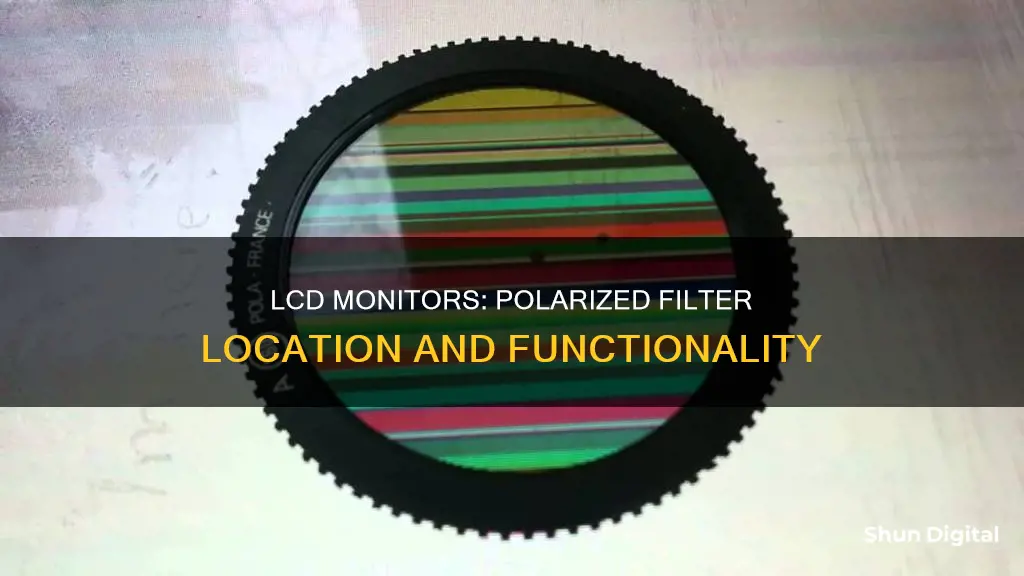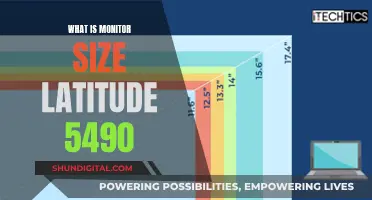
Liquid crystal displays (LCDs) are made up of several layers, including a light source, crossed optical polarizers, and a layer of liquid crystal. The polarizing filter in an LCD monitor is typically found sandwiched between two layers of liquid crystal, with their polarization directions at 90 degrees to each other. The filter allows light waves of a specific polarization direction to pass through it, while blocking others. This property of polarizing filters is essential for controlling the brightness and colour of each pixel on an LCD display. Removing the polarizing filter from an LCD monitor can result in a stealth display, where the screen appears bright and blank to the naked eye, but can be viewed normally through polarized lenses.
| Characteristics | Values |
|---|---|
| What is a polarizing filter? | A material, usually a special type of transparent crystal, which allows light waves of a specific polarization direction to pass through it. |
| How does it work? | Vertically polarized light waves pass through the filter unaffected, while horizontally polarized waves are completely blocked by it. |
| What happens to a wave that is in between horizontal and vertical polarization? | Such a wave can be thought of as being made of a vertical and a horizontal component, and only its vertical component passes through the filter, resulting in diminished strength. |
| How does a liquid crystal display (LCD) work? | An LCD pixel is made up of numerous layers, but must include a pair of linear polarizers and a thickness of nematic liquid crystal with transparent electrodes that can apply a voltage across the liquid crystal. |
| What happens when there is no applied voltage across the liquid crystal? | The thickness of the liquid crystal is set so that it rotates the polarization of the light by 90 degrees in the no-voltage state. This converts the horizontally polarized light leaving the first polarizer into vertically polarized light ready to enter the second polarizer. Finally, the light passes through the second polarizer and appears as a bright pixel. |
| What happens when there is an applied voltage across the liquid crystal? | The voltage causes the liquid crystal's rod-like molecules to line up with the applied field. In that configuration, there is no structure to alter the polarization of the light, so the light leaving the liquid crystal is still horizontally polarized. This light cannot pass through the vertical polarizer, so this appears as a dark pixel. As the level of the voltage is changed, the pixel can let any amount of light pass through, from bright to dark. |
| What happens when the outer polarizer of an LCD is rotated? | Rotating the outer polarizer of an LCD causes the display to show negative images. |
| What happens when the final polarizing film is removed from an LCD display? | An LCD display from which the final polarizing film has been removed appears to be bright and featureless to the human eye, as the eye is not very sensitive to the polarization of light. |
What You'll Learn

LCD monitors have multiple layers
The light source in an LCD monitor is typically a set of LEDs or, in older models, CCFL (Cold Cathode Fluorescent Lamps). The light is initially polarized by passing through a horizontal polarizer. It then passes through a liquid crystal layer, which can alter the polarization of the light. By applying a voltage across the liquid crystal layer through transparent electrodes, the molecules can be aligned to either allow or block the passage of light, creating bright or dark pixels.
The key component in this process is the liquid crystal layer, which can "twist" the polarized light as it passes through. This twisting effect is controlled by an electric field applied to the transparent electrodes, allowing for precise manipulation of the light's polarization. The liquid crystal layer is typically sandwiched between two polarizing filters oriented at 90 degrees to each other.
The combination of polarizers and the liquid crystal layer enables the independent control of each pixel's brightness in an LCD display. This intricate layering and manipulation of light are what give LCD monitors their ability to display a wide range of colours and images.
It is important to note that the human eye is not very sensitive to the polarization of light. Therefore, if the final polarizing filter is removed from an LCD display, it will appear bright and featureless to the naked eye. However, by wearing vertical polarizing filters or using a device with a vertical polarizer, such as a pair of polarizing sunglasses, the original image can be seen again. This property of LCD monitors has led to creative applications, such as building "stealth" computer displays that can only be viewed using polarizing filters.
Opening the ASUS Monitor PG278QR: A Step-by-Step Guide
You may want to see also

The polarizing filter can be removed
To remove the polarizing filter, carefully cut the edges of the outer polarization film and then scrape and pry it off with a chisel or hobby knife. Removing the filter will result in a white screen, as the human eye is not sensitive to the polarization of light. However, the display will still be visible through a second pair of polarizing filters, such as another set of LCD glasses or polarizing sunglasses.
This trick can be used to create a "stealth" monitor, which will appear blank to anyone not wearing the polarizing glasses but will appear completely normal to those wearing them. It is not a very secure method of preventing eavesdropping, as anyone with polarizing glasses will be able to read the display.
Monitoring App Usage: Android's Built-in Tools for Control
You may want to see also

The filter can be used with glasses to see the display
The polarizing filter in an LCD monitor can be used with glasses to see the display. This is achieved by removing the polarizing filter from the LCD display and placing it in front of the glasses. This allows the wearer to see the display as normal while making the screen appear blank to anyone not wearing the glasses.
To create this effect, carefully remove the outer polarizing filter from an LCD display. You can use an old LCD display for this, such as an old calculator or phone screen. Then, install the filter in place of the lenses in a glasses frame. The display will now appear bright and blank to anyone not wearing the glasses, but will be visible through the glasses.
It is also possible to use polarizing sunglasses to view the display. The polarizing filters in the sunglasses and the LCD screen counteract each other, causing the screen to appear dark or black. By rotating the screen 90 degrees, you can position the screen's polarizing filters to block light waves travelling in the same direction as the sunglasses, allowing light to pass through and the screen to be visible.
This trick works because LCD displays use liquid crystals that can rotate the polarization axis of light as it passes through. The display consists of several layers, including a source of light, crossed optical polarizers, and a layer of liquid crystal bounded by transparent electrodes. By removing the outer polarizing filter, the display shows uniform illumination with a varying pattern of polarization, which appears bright and featureless to the human eye. However, when viewed through a vertical polarizing filter, such as polarizing sunglasses or the removed polarizing filter, the original image becomes visible again.
Monitoring Water Usage in Hillsborough, California: A Guide
You may want to see also

LCD displays work with liquid crystals
LCD stands for Liquid Crystal Display. LCD screens are flat-panel displays that use liquid crystals in their primary form of operation. They are commonly found in smartphones, televisions, computer monitors, and instrument panels. LCDs have largely replaced older display technologies such as cathode-ray tube (CRT) displays, light-emitting diode (LED) displays, and gas-plasma displays.
LCDs work on the principle of blocking light rather than emitting it. They use a backlight to produce images, and the liquid crystals within the display rotate polarized light. A polarizing glass filter is placed in front of and behind all the pixels, with the front filter placed at 90 degrees to the back filter. The liquid crystals are electronically switched on and off, allowing them to control the amount of light that passes through to the surface of the display.
Each pixel of an LCD typically consists of a layer of molecules aligned between two transparent electrodes, often made of indium tin oxide (ITO). These electrodes are placed on the inner surfaces of two glass substrates, with the liquid crystals sandwiched between them. The electrodes control the behaviour of the liquid crystals by creating an electric field that runs through them, which in turn changes the alignment of the crystals. This affects the overall behaviour of the molecules and the amount of light that passes through the display.
The light from the backlight passes through the back polarizer and back substrate into the liquid crystals. The liquid crystals can be aligned in different ways, such as twisted nematic or multi-domain, and this alignment determines how the light behaves as it passes through. For example, in twisted nematic liquid crystals, the crystals are oriented in a twist when no electric field is present, which polarizes the light passing through. When an electric field is applied, the twist straightens out, and the light is no longer polarized and thus cannot pass through the front polarizer.
For colour displays, the light passes through an RGB (red, green, blue) colour filter after being polarized by the liquid crystal layer. Each pixel is made up of three sub-pixels, each with a red, green, or blue filter. By controlling the degree of light passing through each sub-pixel, different colours can be produced. With all the pixels on a display working together, the display can create millions of different colours.
How Do Apartments Monitor Water Usage by Each Unit?
You may want to see also

The filter can be replaced after rotating it 90 degrees
Liquid crystal displays (LCDs) are made up of several layers, including a light source, crossed optical polarizers, and a layer of liquid crystal. The polarizing filter in an LCD monitor is typically found on the outer layer of the screen.
It is important to note that this procedure should not be performed on expensive LCD monitors, as it may void the warranty and cause damage. However, for those with old or broken monitors, it can be a fun experiment to try.
Additionally, it is worth mentioning that the polarizing filter from an old LCD screen can be repurposed as a photography filter. By carefully disassembling the device, the transparent layer acting as a polarizing filter can be extracted and used to suppress glare and enhance photos, especially when paired with a smartphone camera.
Choosing the Right Monitor Size for Viewing 11x17 Plans
You may want to see also
Frequently asked questions
An LCD monitor has two polarizing filters, which are layers of a special type of transparent crystal.
The filters allow light waves of a specific polarization direction to pass through them.
The display will appear white or show negative images, and can be viewed using a pair of polarizing sunglasses.
Yes, you can use a pair of polarizing glasses or a linear polarizer.
Examples of devices with LCD screens include computer monitors, calculators, and old Nokia phones.







